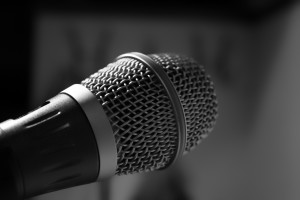We’ve all experienced a presentation about a topic in which we were really interested, only to be let down by the presenter. It’s a terrible feeling, expecting one thing and getting another. Especially when what you get is so much less than what you expected.
You can create the best presentation and attempt to overcome your fear of speaking, but it’s what happens when you’re actually presenting that determines your presentation’s impact on your audience.
 The truth is that I’ve had presentations go really well and I’ve had some fall flat. How well a presentation goes, depends on some pretty standard items.
The truth is that I’ve had presentations go really well and I’ve had some fall flat. How well a presentation goes, depends on some pretty standard items.
Here are my 20 tips for giving fabulous presentations.
1. Prepare your person
Some of my worst presentations were because I didn’t like what I was wearing, felt tired, hadn’t drank my coffee yet, or was emotionally disconnected. Prepare your personal self for the presentation by getting plenty of rest, following your morning routine, test driving your appearance plan, and leaving everything else in your life at the door. Your audience deserves for you to be fully prepared and present.
2. Know your audience
You can’t know too much about your audience before a presentation begins. Knowing your audience helps you relate to them and ensures that you provide the right type and level of information they need. Know things like:
- Who will attend the presentation?
- How much do they know about the topic?
- What will the audience be doing before, during and after the presentation?
- What does the audience hope to get from the presentation?
3. Practice in advance
Practicing what you plan to say helps you feel prepared and eliminates fear. Practicing in front of other people is helpful, but rehearsing in front of a mirror also is useful.
Practicing in the location where you’re presenting is preferable, but not always possible.
Regardless, you must practice out loud. Reading a speech or presentation is not the same as saying it out loud. When you practice with your voice, you are able to work through or write around problems in your presentation.
4. Arrive early
Always arrive early for your presentation. This allows time for you to get a feel for the room (if you haven’t already practiced there) and work out any tech-related issues.
5. Have your gear
Rarely do things go according to plan when setting up for the presentation. I always arrive early with a bottle of water, my laptop, my presentation in three formats (digital, paper and on an external drive), and all of possible adapters that work with my computer. I never assume the venue has anything I need for my presentation. I’m rarely unprepared.
6. Use the mic
Never assume that people can hear you during a presentation just because you’re loud. Speak loudly and confidently, but always use the mic. People will tune out of your presentation if they’re straining to hear you.
7. Lead strong
How you start your presentation sets the tone for the overall experience. Never start your presentation with an apology or asking if everyone can hear you. Instead, start with an engaging story or an interesting fact that illustrates your presentation’s overall objective. You need to capture your audience’s attention in the beginning and make them want to listen to more.
8. Focus on objectives
You presentation should be based on your objectives for your audience and built around key points you want to communicate. Don’t lose sight of these during the presentation. Remember the single thing you want to make sure your audience knows, understands or remembers as a result of your presentation.
9. Be relatable
The audience wants to connect with you as a human. Telling personal stories or joking about yourself can humanize you.
10. Consider slides
Every presentation does not need a slide deck. But, if you choose to use one, make sure your slides support, enhance and reinforce your presentation’s main content.
Remember, if you choose to use slides, never to turn your back on the audience. You never should read the slides. Instead, the slides should simply show one or two key words that your spoken presentation build upon.
11. Remove barriers
Don’t stand behind a podium, table, etc. during your presentation. Move toward your audience and speak to them barrier free to form a better connection.
While you should remove barriers and move around, also remember not to pace or move so much that it becomes distracting.
Another great way to remove barriers during your presentation is to make eye contact with people in the audience. I like to find people smiling or nodding their heads (showing supportive body language) and repeatedly make eye contact with them. Seeing supportive people in the audience also helps to calm nerves.
12. Ask questions
Asking questions, even rhetorical ones, forces people to think about how they would answer, which applies the material to their lives. It gets them involved in the presentation.
13. Tell stories
People love to hear stories about other people. Be sure to incorporate stories that support your objectives into your presentation.
14. Add a summary
People learn better when things are packaged for them. Give them a recap and takeaways of your key points at the end of your presentation.
15. Stick to the time
Don’t show a lack of respect for your audience by going beyond the allotted time. Pay close attention to timing and pacing, and wrap up the presentation on schedule.
16. Allow Q&A
Give your audience a chance to ask you questions. Be aware of time and cut them off when necessary.
17. Provide contact information
Allow the audience to contact you if they have further questions or want to connect. I usually put this information on my final slide, and show it as I wrap up.
18. Request feedback
The best way to learn how well you did is to ask for feedback. You can encourage your audience to use the contact information you’ve provided to tell you what they thought of the presentation. Just remember not to take feedback too personally.
19. Watch tape
Watching your own presentation is a humbling and eye-opening experience. I encourage you to watch video of yourself presenting, if such a thing is available. While it is difficult to do, it will help you become a better presenter.
20. Seek opportunities
The best way to become a fabulous presenter is to present. Seek out opportunities to speak publicly. The practice will help you improve.
If you’ve done any presenting at all, you’ve had positive and negative experiences. Some presentations just go better than others. My hope is that these tips will help you give fabulous presentations that meet your audience’s needs every time. Good luck!



profkrg thanks for this! One q abt strong opening. Do you think it’s best to jump right in or to thank ppl first?
tanyaboza I like to open with a story, then introduce myself and go from there. I thank at the end.
profkrg good strategy. The norm in academia is to thank first, but that may affect initial impression in precious first moments.
tanyaboza exactly. When I’m presenting research, I introduce myself/university first.
profsivek Rely only on FollowerSale when it’s about REAL Followers – 40% discount http://bit.ly/1BosGl3 http://twitter.com/RudyMorrisvv/status/551044045192318976/photo/1
barneydavey appreciate it, Barney.
DrMichelleMazur Thank you, Michelle, for the support.
profkrg Sure thing!
ShellyKramer Thank you, Shelly. Happy Monday!
profkrg You’re welcome! Hope your Monday has been a good one.